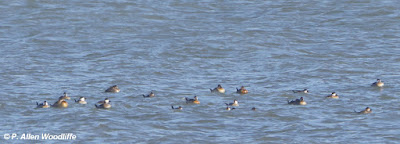The Christmas Bird Count (CBC) season is upon us, and the Blenheim/Rondeau count is on Dec 17. As the weather can be a big factor in the number of birds seen, there is a three day period before as well as after the actual count day, where birds can be included in the overall count database. However birds seen during the count period but not on the count day, will not be included on the count itself. Therefore there is a bit of effort to scout around during the count period to see what might be seen on the day, or could have been seen.
With this in mind, I try to get out a bit more prior to or during the count period, and with the unseasonably mild weather of late, who know what is still out there? Recently there have been things such as Blue-gray Gnatcatcher and White-eyed Vireo seen. Just before the count period, I encountered a Great Egret at the Keith McLean Conservation Lands. It moved around a lot, probably because it was likely wondering just what it should do with itself this late in the season, but probably also because I tried to get a bit closer at times. While there is no hunting taking place at this location, it may have encountered hunters elsewhere, which made it extra cautious when humans were in sight. It was sometimes sitting right out in the open....
A Great Blue Heron was also quite close by, with its feathers being rustled around in the wind.
With all of the mudflats being available and temperatures sometimes getting well above freezing, it is inevitable that there may be a few lingering shorebirds. There has been the occasional Dunlin around, as well as Killdeer. I came across a scattered group of 10 Killdeer at the Erieau Marsh Trail recently, which gave me some quite good photo ops.
It was fairly windy, and a cold wind was coming off the lake nearby. This individual came quite close to me, and hunkered down behind a raised clump of mud, to get some protection from the wind, I presume. Even at this spot the breeze was blowing its feathers as you can see.
Others seemed to be okay with just standing out in the open at the water's edge, facing into the wind.
The south beach of Rondeau can be very good for lingering shorebirds under the present conditions. Last year on the CBC we had Killdeer, Dunlin, Spotted Sandpiper and Western Sandpiper. I will not be covering that area this year, others will, and the weather looks less than ideal for being out in such exposed conditions. However some shorebirds may still be out there nonetheless. Stay tuned...
Meandering around Rondeau has had a variety of results. I've not only encountered, but photographed Pileated Woodpecker on a couple of occasions. The sky background can play a huge part in the satisfaction of the photos.
Cedar Waxwings are declining in abundance, but are still around. This one spent all of its time in a fairly dense stand of shrubs.
Dark-eyed Juncos are fairly plentiful, and widely scattered.
House Finches are year-round residents, so not all that surprising to see.
 |
| female |
 |
| male |
White-throated Sparrows are often the most numerous sparrow species at this time of year.
There are a few lingering Yellow-rumped Warblers, most likely to be encountered in the semi-open north campground where there are lots of red cedars.
On the lake front, diversity of waterfowl varies, but at this time of year large numbers of Ruddy Ducks are often seen. There were at least 450 of them within my view, but out quite a way, so this photo shows a greatly cropped view of a few of them that were a little closer, so I didn't have to crop the photo as much.
Tundra Swans are either out in the lake or bay, or feeding in fields.
Due to the milder than normal weather, I came across this Eastern Comma on December 15, which I believe is the latest in the year I have ever seen this species. Presumably as the weather cools down, it will find a safe place to over winter.
If you would like to subscribe, or unsubscribe, to Nature Nuggets, send an email to: prairietramper@gmail.com


















No comments:
Post a Comment